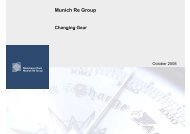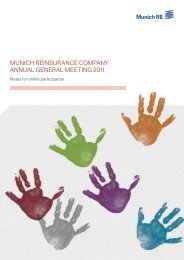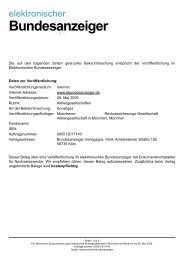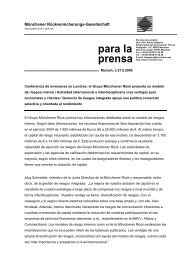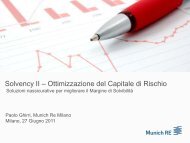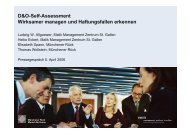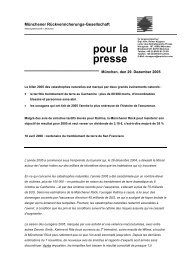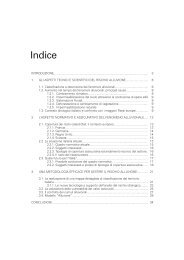Quarterly Report 3/2008 (PDF, 308 KB) - Munich Re
Quarterly Report 3/2008 (PDF, 308 KB) - Munich Re
Quarterly Report 3/2008 (PDF, 308 KB) - Munich Re
Create successful ePaper yourself
Turn your PDF publications into a flip-book with our unique Google optimized e-Paper software.
Interim management report Business experience<br />
The volume of our investments in shares at carrying amounts (including<br />
those in affiliated and associated enterprises) fell €8.4bn to €15.7bn during<br />
the course of the year. This was due on the one hand to our selective equity<br />
port folio cutbacks in the third quarter of <strong>2008</strong> by disposing of hedged items,<br />
and on the other hand to the sharp setbacks in share prices on the stock<br />
exchanges, especially towards the end of the third quarter. At market value,<br />
our equity portfolio (including investments in affiliated companies and associates)<br />
represents 9.3% of our overall investment portfolio – down 4.5 percentage<br />
points compared with the start of the year. However, because we have<br />
hedged this portfolio to a large extent using derivatives, at the end of the quarter<br />
our economic exposure to equities accounts for only 4.6% (10.8%) of our<br />
investments at market value. This decreased ratio is mainly attributable to the<br />
greater use of additional derivative financial instruments in the third quarter.<br />
Expressed as a percentage of adjusted equity 1 , the value of investments in<br />
equities – minus derivatives, policyholders’ bonuses and deferred taxes – is<br />
only 22% (“equity gearing”). Proceeding from a percentage of 51% at the end<br />
of the previous year, we have significantly reduced our dependence on the<br />
stock market in the current financial year also in relation to our equity capital,<br />
in the light of the volatile capital market environment.<br />
At the end of the quarter, fixed-interest securities and loans accounted for<br />
€136bn or approximately 79% of our total investment portfolio at carrying<br />
amounts, which is around five percentage points more than at the beginning<br />
of the year. In this segment, we have been considerably more circumspect<br />
than many of our major competitors and have been very restrained with<br />
regard to the assumption of credit risks. Only since the start of the year have<br />
we cautiously expanded our portfolio of credit-exposed fixed-interest securities,<br />
particularly asset-backed securities, mortgage-backed securities and<br />
corporate bonds. We took advantage of the considerable widening of risk<br />
spreads in comparison to government bonds to restructure our portfolio<br />
accordingly and earn higher interest income.<br />
At the reporting date, our portfolio of asset-backed securities and mortgagebacked<br />
securities totalled €6.7bn, which corresponds to an increase of approximately<br />
€1.2bn since the beginning of the year, chiefly effected in the first<br />
quarter. We invest only in assets with a high credit rating. Consequentially,<br />
our portfolio has a good rating structure: as at 30 September <strong>2008</strong>, 98.5% of its<br />
securities were rated A to AAA. Even though the credit crisis has made it clear<br />
that the ratings of complex financial instruments are of limited relevance as an<br />
analysis tool, we consider our portfolio to be relatively low-risk in the current<br />
economic circumstances.<br />
With our investments, we anticipated the risk of continued inflation expectations<br />
at an early stage, gradually adding to our portfolio of inflation-indexed<br />
bonds over the course of the year to protect us from the inflation risk and the<br />
associated increase in interest rates. These bonds are linked to a consumer<br />
price index, ensuring that where there is inflation, interest payments and<br />
redemptions increase continuously. As at 30 September <strong>2008</strong>, the volume of<br />
inflation-indexed bonds at market values was just under €7.5bn (3.3bn), thus<br />
making up around 5.6% of our portfolio of fixed-interest securities and loans<br />
at market values.<br />
On 13 October <strong>2008</strong>, the IASB (International Accounting Standards Board)<br />
fast-tracked an amendment of IAS 39, Financial Instruments, relating to<br />
the reclassification of financial instruments. In the light of the crisis on the<br />
financial markets, the changes made are intended to eliminate the potential<br />
competitive advantages of US banks by aligning IFRS with US GAAP, and to<br />
provide balance-sheet relief in the financial sector.<br />
1 Disregarding minority interests and goodwill and including net off-balance-sheet reserves.<br />
<strong>Munich</strong> <strong>Re</strong> Group <strong>Quarterly</strong> <strong><strong>Re</strong>port</strong> 3/<strong>2008</strong><br />
15





